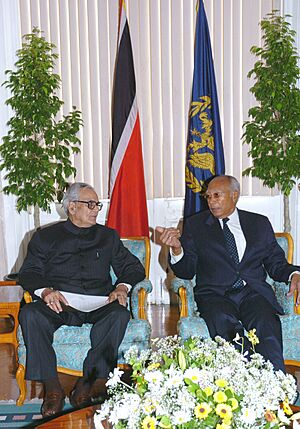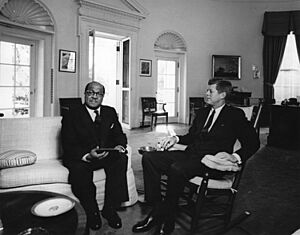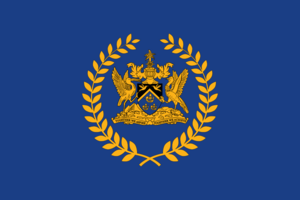President of Trinidad and Tobago facts for kids
The President of Trinidad and Tobago is the country's head of state and the leader of its armed forces. This important role was created in 1976 when Trinidad and Tobago became a republic. Before that, the head of state was Queen Elizabeth II. The last Governor-General, Sir Ellis Clarke, became the first President on August 1, 1976. He was officially chosen by a special group of Parliament members on September 24, 1976. This date is now celebrated as Republic Day.
The President's job was briefly paused during a period of national events from July 27 to August 1, 1990, but it quickly resumed. The current President of Trinidad and Tobago is Christine Kangaloo.
Quick facts for kids President of theRepublic of Trinidad and Tobago |
|
|---|---|

|
|

Presidential Emblem
|
|
| Style | His/Her Excellency |
| Residence | President's House, Port of Spain, Trinidad and Tobago |
| Appointer | Electoral college consisting of all of the members of the Senate and House of Representatives |
| Term length | Five years
renewable indefinitely
|
| Constituting instrument | Constitution of Trinidad and Tobago |
| Precursor | Queen of Trinidad and Tobago |
| Inaugural holder | Sir Ellis Clarke |
| Formation | September 24, 1976 |
| Deputy | President of the Senate |
| Salary | TT$64,270 monthly (2022) |
Contents
Becoming a Republic
The Path to Presidency
In 1969, the Prime Minister suggested that Trinidad and Tobago should become a republic. This meant the country would have its own head of state instead of the British Queen. A special committee was formed to study this idea.
After some time, a new commission was set up in 1970. This group was tasked with making recommendations for a new constitution. Their full report and a draft constitution were given to the Governor-General in 1974.
In 1975, Prime Minister Dr. Eric Williams presented the draft constitution to Parliament. Both houses of Parliament approved the Constitution of the Republic of Trinidad and Tobago Act on March 26, 1976. The Governor-General signed the bill into law on March 29.
The new constitution officially began on August 1, 1976. On this day, Trinidad and Tobago became a republic within the Commonwealth. The role of the Queen and the Governor-General was ended. Sir Ellis Clarke, who was the last Governor-General, became the country's first President.
How the President is Chosen
Electoral Process
The President of Trinidad and Tobago is chosen for a five-year term. This is done through an electoral college. This college includes all 41 members of the House of Representatives and all 31 members of the Senate. The speakers of both houses are also part of this group.
To be President, a person must be at least 18 years old. They must also be a citizen of Trinidad and Tobago. At the time they are nominated, they must have lived in the country for ten years without a break.
A candidate wins the election by getting the most votes. For the election to be valid, a certain number of members must be present. This includes the Speaker of the House, 10 Senators, and 12 other members of the House. If only one person is nominated, they become President without a vote.
The Presidential Oath
When a President takes office, they say a special oath. This oath promises that they will be loyal to Trinidad and Tobago. It also states they will protect the Constitution and the law. They promise to do their job fairly and to serve the people of Trinidad and Tobago.
"I, (name), do swear by Almighty God that I will bear true faith and allegiance to Trinidad and Tobago and to the best of my ability preserve and defend the Constitution and the law, that I will conscientiously and impartially discharge the functions of President and will devote myself to the service and well–being of the people of Trinidad and Tobago".
What the President Does
Constitutional Duties
The 1976 Constitution set up a parliamentary system of government. This system is similar to the one in the United Kingdom. The President has important legal and practical roles. Like other parliamentary republics, the President of Trinidad and Tobago has significant constitutional powers.
However, in practice, the Prime Minister and their Cabinet usually carry out the executive power. They advise the President on how to use these powers. The President "reigns but does not rule." This means they are the official head of state, but the government makes the daily decisions.
Executive Powers
The President is the official source of executive power. One of their main jobs is to appoint the Prime Minister. The Prime Minister then leads the Cabinet and advises the President on government matters. The President's role is mostly symbolic. They represent the legal authority for all government actions.
The Cabinet directs how the President's executive power is used. This includes declaring war, calling Parliament meetings, and calling elections. However, the President can use some powers on their own in special situations. These include dismissing a Prime Minister or dissolving Parliament.
The President appoints other ministers based on the Prime Minister's advice. The President is kept informed by the Cabinet through regular updates.
Foreign Affairs

The President's power also covers foreign affairs. The President can negotiate and approve treaties and international agreements. But usually, the Prime Minister and Cabinet handle these talks. The President also officially welcomes diplomats from other countries. They also send Trinidad and Tobago's ambassadors to other nations.
Role in Parliament
The President is one of the three parts of Parliament, along with the Senate and the House of Representatives. Since the President usually acts on the Cabinet's advice, their role in making laws is limited. They sign bills into law. However, the President has the power to refuse to sign bills passed by Parliament. This is called a veto.
The Constitution also says the President appoints senators. They appoint 16 Government Senators on the Prime Minister's advice. They appoint 6 Opposition Senators on the advice of the Leader of the Opposition. They also appoint 9 Independent Senators from outstanding people in society.
The President also calls, pauses, and dissolves Parliament. After Parliament is dissolved, the President usually issues the official orders for a general election. These powers are almost always used on the Cabinet's advice.
Judicial Powers
The President has the power to appoint judges. This is done based on the joint recommendation of the Prime Minister and the Leader of the Opposition. The President can also pardon people who have committed crimes.
Cultural and Ceremonial Role

Beyond their official duties, the President also has a role in representing the country. This ceremonial role depends on the times, the person in office, and the government's wishes. Presidents often support charities and give out awards. They host events for different groups, including ambassadors. They also travel around Trinidad and Tobago.
Public Presence and Duties
The President represents the country at home and abroad. They take part in government ceremonies in Trinidad and Tobago or elsewhere. The President and their spouse attend important events like national milestones or cultural celebrations. They also attend Independence Day events, award ceremonies, and Remembrance Day.
The President provides non-political leadership in the community. They act as a patron for many charitable, sports, and cultural groups. They attend events across the country.

The President also helps unite the people of Trinidad and Tobago. In this role, the President:
- Often welcomes citizens, students, and visitors to President's House.
- Attends religious services and charitable events.
- Accepts patronage of many national organizations.
- Sends congratulatory messages for special anniversaries and events.
Military Duties

The President is the Commander-in-Chief of the armed forces. This includes the Trinidad and Tobago Regiment, Coast Guard, Air Guard, and Defence Force Reserves. While they are technically in charge, the President does not usually give direct commands. Instead, they follow the advice of the Minister for Defence. This role is mostly ceremonial. The President takes part in military ceremonies like independence parades and troop inspections.
Presidential Privileges
Salary
As of 2022, the President receives a monthly salary of TT$64,270.
Symbols
The official presidential flag can be flown from the President's vehicle or a building where they are present. This flag was adopted in 1976. It is blue with the Presidential Emblem in the middle. It is considered more important than the national flag. The national flag is used when the President visits other countries or on national holidays. The national flag is also flown at half-mast when a President or former President dies.
Title and Address
In Trinidad and Tobago's official order of importance, the President is ranked highest. The President and their spouse are called "His/Her Excellency" while in office. They keep this title for life after leaving office. When you meet the President, the correct way to address them is "Your Excellency."
Official Residence
The President's official home is President's House. It was once called Government House when governors used it. Today, it is the President's private home. It is also used for national awards, swearing-in ceremonies, and diplomatic receptions.
Images for kids
See also
 In Spanish: Presidente de Trinidad y Tobago para niños
In Spanish: Presidente de Trinidad y Tobago para niños






